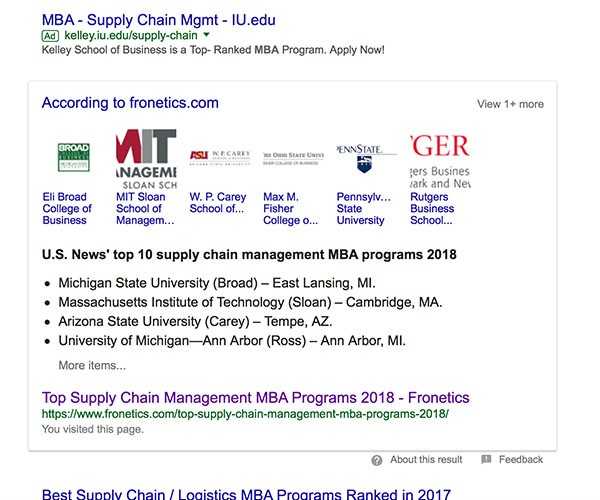
by Fronetics | Jan 3, 2018 | Blog, Content Marketing, Marketing
In part one of a four-part series on writing for SEO, we address how search engines and the search landscape have changed recently.
Content marketing has seen a lot of changes in the past few years. These changes are largely results of the rapidly evolving search landscape, as well as a seismic shift in the way people are actually discovering content. New, more sophisticated search algorithms, changes in the way people use search engines, and new ways that marketers develop their content are just a few of the contributing factors and outcomes.
Over the next few weeks, we’ll be writing a series of posts examining how marketers should approach writing for SEO in this new landscape. Today, we’re exploring specifically how search engines have evolved — something they are always doing, as they improve to help searchers find the content that best answers their queries.
Are keyword rankings still important?
It’s important to recognize that as search engines change the way they process and evaluate content, older metrics of SEO success aren’t as reliable as they used to be. Take keyword rankings for example. While conventional wisdom tells us that it’s absolutely necessary for content marketers to check their Google keyword rankings for target keywords, debate has swirled recently about the actual reliability of this metric.
Why is this once-standard metric being called into question? The answer is largely about context: Search engines have evolved beyond the point where everyone gets the same results of a query, and therefore rank can change drastically depending on context.
Location-based searches are one of the most obvious and important contextual variables. Simply put, depending on where you’re searching from, you’ll see different search results. This makes it difficult and unreliable to evaluate success based on keyword rankings alone.
Featured snippets
In addition to keyword-ranking problems, search engines are starting to dictate how content should be structured — particularly with the increased appearance of featured snippets. These snippets typically display content from within one of the pages ranking on page one of a question-based query, directly answering the question searched for without the user ever having to visit the actual page.

Fronetics has the featured snippet for Supply Chain Management MBA Programs.
A recent study found that of 1.4 million queries, 30% showed a featured snippet — that’s big growth. This means that content that ranks within the featured snippet section often gets a much greater share of the traffic for the given query. For content creators, this points to a need to restructure content to try to appear within these featured snippets.
Changes to the way search engines work do present a challenge for content creators writing for SEO. But keeping pace with the ever-changing technology is key to keeping your content relevant.
Make sure to check out part 2 in our series, Writing for SEO: People Are Changing How They Search, part 3, Writing for SEO: Topic Clusters and Pillar Content (NOT Keywords), and part 4, Writing for SEO: Measuring the Success of Your Content.
Related posts:

SaveSave

by Fronetics | Jan 2, 2018 | Blog, Content Marketing, Logistics, Marketing, Social Media, Supply Chain
It’s time to cast your vote for the top logistics and supply chain blogs of 2018!
We love hearing about your favorite logistics and supply chain blogs. We’re conducting our 4th annual survey to uncover the top industry blogs of 2018. Help us by voting for your favorite. Responses will be collected through Friday, January 26, 2018.

All responses are confidential and will be reported in aggregate. No identifiable information (individual or company) will be attached or included. Please contact [email protected] with any questions.
Interested in our past winners? Here they are!

SaveSave

by Fronetics | Dec 19, 2017 | Blog, Marketing
Email is one of the most utilized tools in your marketing toolbox, but marketers need to continuously develop their email practices to keep up with the rapidly changing interests of audiences.
Email marketing is a powerful tool for growing and developing your business. You probably get hundreds of marketing emails from all kinds of companies you patronize (and even those you don’t) every day. So you know as well as anyone that not all email marketing is created equal.
Especially in B2B culture, there is a right way — and many wrong ways — to do email marketing. Our blog hit on many best practices in 2017 that are important for B2B marketers to keep in mind as they create marketing emails.
Here are the top 7 email marketing posts for 2017.
1. 7 Email Marketing Tips for Manufacturers and Industrial Companies
Here are seven tips for manufacturers to improve your email marketing strategy in the manufacturing and industrial sector. Many manufacturers and industrial companies are still stuck in the one-off batch and blast mode of email marketing. That strategy is not likely to work very well in industrial marketing, where most of the purchases include complex products with long sales cycles, multiple decision-makers, and stakeholders are involved. Read more.
2. 7 Techniques for Personalizing Marketing Emails and Boosting Engagement
Personalizing marketing emails increases open rates, click-throughs, and revenue, but it takes so much more than addressing recipients by name. Marketers can use information they have about subscribers to tailor email content for individuals, based on who they are or where they are in the buyer’s journey. Read more.
3. 4 Email Marketing Stats that Prove You Spend Too Much Time Creating Emails
Email marketing can be a challenge — to say the least. The constantly changing email landscape, marketing trends, and privacy regulations can make staying on top of your email game very tough. Take a look at these 4 statistics and why streamlining and automating certain aspects of your email marketing program might free you up to focus on factors that can make a difference. Read more.
4. Increase Revenue from Marketing Emails by 760% with This One Trick
Email list segmentation is the one of the simplest and most critical practices to improving marketing email performance. Marketing emails are an important part of lead nurturing: They can make or break whether a lead becomes a sale. So marketers spend a lot of time and money thinking about how to perfect their messages. Read more.
5. 5 Biggest Email Subject Line Mistakes to Avoid
Email marketers, beware: If you’re tasked with writing compelling emails to capture online customers, the subject line — the headline of your message — is the first and main spot to grab the viewer’s attention. But, while a cleverly written subject can boost open rates and click-throughs, a poorly written one can have the opposite effect. Read more.
6. Three Marketing Email Crimes to Avoid
Are your marketing emails annoying your customers and prospects? We’ve all felt it: the visceral annoyance on opening an email — because it’s the fifth one from the same company in two days, or because it’s packed with hyperbole or an off-putting sales pitch. As it turns out, recent research has shown that this reaction is only too natural. We’re predisposed to view the tone of email more negatively than it was written. Read more.
7. Mobile-Friendly Emails: 6 Tips for Success
Use these 6 tips for more mobile-friendly emails to improve recipient engagement rates and to promote profitable customer action. When a majority of your audience is reading your marketing emails on their mobile devices, it’s imperative that you’re creating emails that are optimized for mobile viewing. Here are 6 essential tips for creating mobile-friendly email campaigns. Read more.
Related posts:


by Fronetics | Dec 13, 2017 | Blog, Marketing, Social Media
Here are our 10 most-read social media posts of 2017.
Today, more than ever, companies are turning to social media to engage with customers and reach new audiences. Brands are using newer technologies to push content marketing to new levels. And it’s working.
Looking at this list, I notice the popularity of posts about how to utilize social media to grow leads and close deals. Knowing when and where to post isn’t enough; with constantly changing platforms, companies need to stay on the pulse of social media to stay ahead of their competitors.
At Fronetics, we hope to serve as an educational resource for companies within the logistics and supply chain industry. Always feel free to reach out and ask us a question or request a blog post if there is a topic about which you need more information. In the meantime, here are the 10 most-read posts about social media from our blog in 2017.
Top 10 social media posts in 2017
1. This is How Often B2B Businesses Should Post on Social Media
Keep these best practices in mind when determining how often to post to social media. It’s not enough to just create interesting and pertinent content; you have to put it out there to reach your target audience. Moreover, the content needs to be delivered consistently over time, at the right time, and in the right place. Read more.
2. 4 Tools to Determine the Best Time to Post on Social Media for Your Business
Find out when your target audience is most active on different social media platforms by using these 4 online tools. It’s not enough to curate content for your social media platforms. Today’s social media users expect fresh, innovative ideas around the clock. And when this content is being shared is just as valuable as what is being shared. Read more.
3. Social Benchmarking: How You Know You’re Killing it on Social Media
Rival IQ’s Danica Benson discusses the importance of social benchmarking and offers three steps for getting started. Benchmarks are key when interpreting data. Organizations of all kinds — large corporations, small privately-owned business, nonprofits, and even sports teams — need to measure their performance to see if they’re efforts are leading to success. Read more.
4. The Best Time to Post on Social Media: A Comprehensive Study
When you are posting on social media could be as important as what you’re posting, and this CoSchedule study attempts to determine the best time to post. Timing is everything. And that statement especially holds true when it comes to posting content to social media. There’s no point in putting in the time and effort to create informative blog posts, inspirational tweets, or captivating Facebook posts if you’re not getting the most exposure you can out of your social media outlets. Read more.
5. Instagram Stories: How the Supply Chain Can Use Them to Engage Prospects and Customers
Instagram Stories offer an on-trend platform for delivering targeted content to B2B buyers and building brand awareness with potential customers. If you haven’t considered using Instagram as part of your social media marketing program, it might be time to change your mind. Read more.
6. 7 Must Follow Twitter Accounts for the Supply Chain Professional in 2017
Turn to these 7 Twitter accounts for news, insights, and thought leadership in the supply chain space. Twitter is a platform for socializing, entertainment, breaking news, lead prospecting, and much more. But Twitter is only as useful as the people you follow. So how do you choose between the 317 million monthly active users? Read more.
7. Leveraging Social Media in the Consumer Electronics Industry
Here are two examples of consumer electronics companies leveraging social media to reach their target audiences, build brand awareness, and drive sales. Supply chain businesses understand that social media is an important marketing tool in today’s marketplace. The consumer electronics industry is no different: Participating in social media has never been more necessary. Read more.
8. #LeggingsGate: The Importance of Emotional Intelligence in Social Media Management
United Airlines failed to apply emotional intelligence to its social media management and will continue to suffer the consequences. The recent #LeggingsGate controversy — in which a United Airlines gate agent refused to allow two young girls flying on friends-and-family tickets to board a flight because they were wearing leggings, which violated company dress code — really got our office talking. The incident is a great example for all businesses on the importance of emotional intelligence in social media management. Read more.
9. Where on Social Media Will Competitors Be Next? Trends in Content Distribution Channels
Recent surveys show video platforms are the next big focus for marketers in terms of content distribution channels. We’re big advocates of social benchmarking against your competitors. But, just as much, we are always thinking ahead, trying to figure out where the industry is going next. It’s important to get ahead of the trends so that you can be right there leading the pack. Read more.
10. Facebook Breaks 2 Billion Users, Instagram Crushes Snapchat, and more Social Media News
In July’s social media news, platforms saw a rise in daily active users and broke records in more than one category. Once thought to be a passing trend, social media is nowhere near slowing down in terms of growth. Next Web reported that India has taken over as the largest audience of Facebook, beating out the U.S. with over 241 million active users. Active users in India are up 27% in the past six months, twice the rate of U.S. users. Read more.
Related posts:


by Fronetics | Dec 12, 2017 | Blog, Content Marketing, Marketing
Our most-viewed content marketing posts indicate that marketers are seeking solutions to improve their content marketing programs.
Supply chain and logistics marketers are increasingly seeing the value of content marketing. It is the most cost-effective method to earn leads and sales because it takes into account the way modern B2B buyers are making purchasing decisions (evaluating content they find on the internet).
Looking at our most-viewed content marketing posts this year, I see a trend: marketers are looking for solutions to improve their content marketing programs. I am currently working on our content calendar for 2018, so if there is anything specific you would like to know about, please feel free to email me with suggestions!
Top 10 content marketing posts
1) 4 Ways to Measure Brand Awareness
Building brand awareness is one of the key benefits of content marketing, but it’s notoriously difficult to measure. These four metrics can indicate that you are successfully drawing the public’s attention to — and heightening their knowledge of — your business. That will ultimately generate leads that turn into sales, which is the end marketing objective. Read full post
2) How to Write Better Headlines for LinkedIn Content in 2017
A study of 2016’s most popular content on LinkedIn used data to measure the most popular headlines and topics. The results are really interesting and say a lot about what content resonates with the general LinkedIn community. Tis post summarizes the most popular headline phrases and the most impactful headline words and topics, and suggests ow to use this knowledge to write more successful headlines for your LinkedIn content. Read full post
3) 4 Steps to Building a Successful DIY Content Marketing Strategy
Setting your content marketing strategy is a crucial first step in trying to reach your target audience. Before you begin writing blogs and posting tweets, you need to set goals. A content marketing strategy outlines the methods by which you will target, reach, and engage your audience. Here are four steps, outlined in the guide, to creating a successful foundation to your content marketing strategy. Read full post
4) Want More Leads? Write Better Content
All too often, marketers fall into the trap of sacrificing quality for quantity in their content writing efforts. It’s an easy mistake to make — the pressure to produce a constant stream of content can naturally lead to a drop in quality. But if you’re not writing high-quality, substantive content, you’re wasting time and energy. If you’re wondering whether your content might not measure up, ask yourself these six questions. Read full post
5) 7 Marketing Tasks Supply Chain and Logistics Companies Should Consider Outsourcing
Everyone needs a little help sometimes. In fact, 52% of B2B marketers attribute stagnancy in success to not having enough time devoted to their marketing programs, and 49% attribute stagnation to content creation challenges. Outsourcing marketing allows you to focus on insourcing your core competencies while delegating specialized tasks to external experts. And it’s important to note that you don’t have to outsource ALL of your marketing. Choosing several areas beyond your staff’s expertise or that are particularly time-consuming can help you improve your marketing efforts and take stress off an overworked internal marketing team. Read full post
6) 10 Stats You Should Know about the B2B Buyer’s Journey
Marketers need to be aware of the ways in which the B2B buyer’s journey has changed over the last decade. The vast amount of information available on the internet has afforded buyers a level of self-sufficiency that renders traditional sales models moot. It drives the need for new strategies, like content marketing and social media marketing. The latest B2B Buyer’s Survey offers insight into how B2B buyers are finding vendors, engaging with them, and — ultimately — deciding to work with one. Read full post
7) 3 Tools for Measuring Your Content Marketing ROI
Analyzing the right metrics is crucial to determining whether you are achieving content marketing ROI. According to our Social Media Use Report, 81% of respondents wanted a tracking and measuring tool to prove their ROI. Your resources are limited, so it’s crucial to evaluate your efforts with meaningful numbers that illustrate their effect on your bottom line. So what are they best metrics to use? Here are three of our favorite tools. Read full post
8) 3 Content Marketing Challenges Large B2B Enterprises Face
B2B enterprises with 1000+ employees face unique content marketing challenges that can hinder a program’s overall success. The Content Marketing Institute’s 2017 B2B Enterprise Content Marketing Report brings many of these issues to light. For example, pressure to produce results quickly is a death sentence for content marketing. And being forced to create content for a brand, rather than a specific audience, can be detrimental to content marketing results. Yes, challenges facing these enterprise marketers are often as large as the companies for which they work. This post looks at some of the reasons why that is, and a few solutions for solving them. Read full post
9) How Word of Mouth Can Work for You
Buyers value the opinions of peers and colleagues. In fact, B2B buyers rank it among their top three resources for information. And, in general, 82% of Americans seek recommendations when making a purchase of any kind. Make their chatter work for you. Here are three tips to turn word-of-mouth marketing into leads. Read full post
10) 3 Quick SEO Tips to Improve Your Blog Right Now
Content marketing aims to draw potential buyers who are searching the internet for products and services like yours to your website. The strategic distribution of content helps search engines understand what your website is all about and direct relevant parties to it. You can help the search engines’ algorithms more effectively link searchers and your content by doing these 3 easy things. Read full post
Related posts:


by Fronetics | Dec 6, 2017 | Blog, Current Events, Marketing, Social Media
The increasing popularity of chatbots is making it harder to ignore how artificial intelligence is helping shape the content marketing landscape.
Chatbots are the latest trend in artificial intelligence for marketers, and the supply chain and logistics industries should take note.
Chatbots can help automate and improve some of your marketing and customer service efforts. But to get the most out of these automated systems, you first must understand what they are and how they work.
What is a chatbot?
A chatbot is s a computer program that simulates human conversation using auditory or textual methods. Basically, it’s software that communicates with your customer inside a messaging app, like Facebook Messenger. Chatbots are similar to email marketing, but, instead of ending up in your inbox, they communicate through a messaging app.
Why are chatbots so popular?
As our mobile devices continue to change the way customers receive and interact with our brands, messaging-app usage has skyrocketed. In fact, 2017 saw a 69% increase in messaging-app users from last year. Business Insider reports the number of people on messaging apps surpassed the number of users on social networks. From iMessage to Facebook Messenger, mobile users are leaning more toward this newer technology to communicate with friends and family.
Why the big drop from email? Because people are buried in emails. On average, office employees receive 121 emails per day. Of those 121 emails, only around 20% are opened — and click-through rates are even lower. More and more companies have stuffed inboxes with repeated emails. Over-communication is the number one reason for readers’ unsubscribing to your email list. Chatbots have alleviated the inbox drama.
Why does my business need a chatbot?
Quality messaging without the spam
Chatbots take the spam out of email marketing. When companies market on a messaging app, they create an easier way for leads to receive educational messages about their brand. Chatbots are an easy and fun way for audiences to engage with your brand, getting answers to their questions and quality messaging about your products and services.
Ease of tracking and segmenting
Your brand will also appreciate the ease of tracking and segmenting your customers through chatbots. Take Facebook Messenger for example; using messenger bots, you can identify who your customers are in less than a minute. No other platform (email, social media) can get you that information as quickly or efficiently.
Increased customer engagement
Getting customers to subscribe to your chatbots is much easier than email subscriptions. Why? The ease of usage and lack of friction on messaging apps creates a more positive customer experience. Businesses can set up chatbots to message any user who comments on your social media pages. They can retarget people who have left your site, offering special discounts or promotions if they place an order. And chatbots can also nurture the sales process by notifying you of potential customers that request a specific action during their interaction with your chatbot.
How do I create a chatbot?
There are plenty of chatbot-building platforms available online. Before you pick a platform, make sure you do your research. Here are three of the top chatbot building platforms.
1. Chatfuel
This chatbot engine will do most of the hard work for you, ideal for those lacking programming experience. MTV, TechCrunch, BuzzFeed, British Airways and Adidas are said to have used Chatfuel to create their chatbots, along with almost 20,000 other users across the globe. The user interface is easy and slick, meaning you could create a chatbot in less than 15 minutes!
2. Chatscript
Launched back in 2011, ChatScript is a ‘next generation chatbot engine,’ which has won the Loebner Prize (awarded for the most human-like examples of artificial intelligence) four times. It provides an open source framework for developers to build and deploy chatbots.
3. Facebook ‘Bots for Messenger’
At its F8 developer conference in April, Facebook launched Bots for Messenger, a tool which allows developers and businesses to build chatbots for its Messenger platform (which is used by almost a billion people). Developers build bots, submit them for review, and then Facebook decides which get onto Messenger. The three main capabilities are its send/receive API, generic message templates, and the ability to customize the welcome screen users first see when interacting with your bot.
Messaging automation is the new email automation. Brands will be looking to join the chatbot craze for the ease, convenience, and the positive customer experience. Have you tried a chatbot program yet? We’d love to hear from you about your experience.
Related posts:











